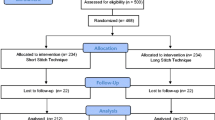Abstract
The effectiveness of using an absorbable suture material for continuous closure of abdominal wounds, especially contaminated wounds, has not yet been determined. Thus, the present study was conducted to investigate the wound complications that developed following continuous closure of clean and contaminated abdominal wounds using polydioxanone (PDS), compared with those that developed following interrupted closure using braided silk. Running closure using PDS was performed in 152 patients (PDS group), while 280 patients who underwent interrupted closure using braided silk served as controls (SILK group). The occurrence rates of wound dehiscence, early wound infection, and incisional hernia did not differ significantly between the two groups; however, the incidence of late suture sinus formation in the PDS group (1.3%) was significantly lower than that in the SILK group (7.1%). Moreover, late suture sinus formation following PDS suturing healed within 1 week after percutaneous drainage alone without removal of suture strings, whereas late suture sinus following braided silk suturing took an average of 16 days to heal and required removal of the infected suture strings in all 20 patients. These findings indicate the potential usefulness of PDS as a suture material to achieve running closure of clean or contaminated abdominal wounds.
Similar content being viewed by others
References
Bucknall TE, Cox PJ, Ellis H (1982) Burst abdomen and incisional hernia: a prospective study of 1129 major laparotomies. Br Med J 284:931–933
Martyak SN, Curtis LE (1976) Abdominal incision and closure: a systems approach. Am J Surg 131:476–480
Dudley HAF (1970) Layered and mass closure of the abdominal wall: a theoretical and experimental analysis. Br J Surg 57:664–667
Richards PC, Balch CM, Aldrete JS (1983) Abdominal wound closure: a rendomized prospective study of 571 patients comparing continuous vs interrupted suture techniques. Ann Surg 197:238–243
Archie JP, Feldman RW (1981) Primary wound closure with permanent continuous running monofilament sutures. Surg Gynecol Obstet 153:721–722
Knight CD, Griffen FD (1983) Abdominal wound closure with a continuous monofilament polypropylene suture. Arch Surg 118:1305–1308
Gallup DG, Talledo OE, King LA (1989) Primary mass closure of midline incisions with a continuous running monofilament suture in gynecologic patients. Obstet Gynecol 73:675–677
Cruse PJE, Foord R (1973) A five year prospective study of 23649 surgical wounds. Arch Surg 107:206–210
Irvin TT, Koffman CG, Puthie HL (1976)Layer closure of laparotomy wounds with absorbable and non-absorbable suture materials. Br J Surg 63:793–796
LoCicero J, Robbins JA, Webb WR (1983) Complications following abdominal fascial closure using various unabsorbable sutures. Surg Gynecol Obstet 157:25–27
Montz FJ, Creasman WT, Eddy G, Disaia PJ (1991) Running mass closure of abdominal wounds using absorbable looped suture. J Gynecol Surg 7:107–110
Rodeheaver GT, Beltran KA, Green CW, Faulkner BC, Stiles BM, Stanimir GW, Traeland H, Fried GM, Brown HC, Edlich RF (1996) Biomechanical and clinical performance of a new synthetic monofilament absorbable suture. J Long-Term Effects Med Implants 6:181–198
Ray JA, Doddi N, Regula D, Williams JA, Melveger A (1981) Polydioxanone (PDS), a novel monofilament synthetic absorbable suture. Surg Gynecol Obstet 153:497–507
Bourne RB, Bitar H, Andreae PR, Martin LM, Finlay JB, Marquis F (1988) In-vivo comparison of four absorbable sutures—Vicryl, Dexon Plus, Maxon and PDS. Can J Surg 31:43–45
Kon ND, Meredith JW, Poole GV, Martin MB, Kawamoto E, Myers RT (1984) Abdominal wound closure: a comparison of polydioxanone, polypropylene, and Teflon-coated braided Dacron sutures. Am Surg 50:549–551
Taylor TV (1985) The use of polydioxanone suture in midline incisions. J R Coll Surg Edinb 30:191–192
Cameron AEP, Parker CJ, Field ES, Gray RCF, Wyatt AP (1987) A randomized comparison of polydioxanone (PDS) and polypropylene (Prolene) for abdominal wound closure. Ann R Coll Surg Engl 69:113–115
Sutton G, Morgan S (1992) Abdominal wound closure using a running, looped monofilament polybuster suture: comparison to Smead-Jones closure in historic controls. Obstet Gynecol 80:650–654
Poole GV (1985) Mechanical factors in abdominal wound closure: the prevention of fascial dehiscence. Surgery 97:631–639
Keys A, Fidanza F, Karvonen MJ, Kimura N, Taylor HL (1972) Indices of relative weight and obesity. J Chronic Dis 25:329–343
Everett WG (1974) Sutures, incisions, and anastomoses. Ann R Coll Surg Engl 55:31–38
Poole GV, Meredith JW, Kon ND, Martin MB, Kawamoto EH, Myers RT (1984) Suture technique and wound-bursting strength. Am Surg 50:569–572
Trimbos JB, Van Rijssel EJG, Klopper PJ (1986) Performance of sliding knots in monofilament and multifilament suture material. Obstet Gynecol 68:425–430
Ellis H, Cajraj H, George CD (1983) Incisional hernia: when do they occur? Br J Surg 70:290–291
Author information
Authors and Affiliations
Rights and permissions
About this article
Cite this article
Iwase, K., Higaki, J., Tanaka, Y. et al. Running closure of clean and contaminated abdominal wounds using a synthetic monofilament absorbable looped suture. Surg Today 29, 874–879 (1999). https://doi.org/10.1007/BF02482778
Received:
Accepted:
Issue Date:
DOI: https://doi.org/10.1007/BF02482778




